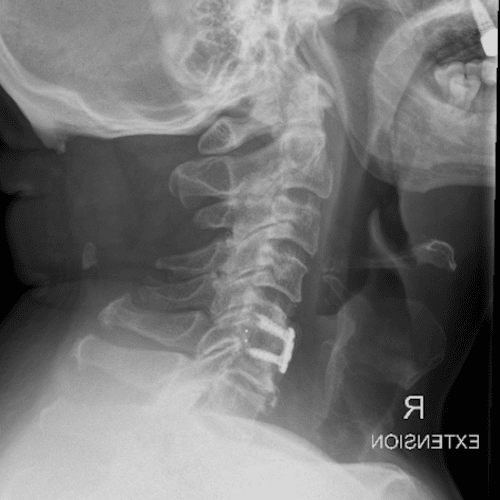Anterior Cervical Discectomy & Fusion (ACDF)
ACDF is a surgery where the A/Prof Buckland accesses the front of your neck, takes out a problematic disc to relieve pressure off the nerve and/or spinal cord, and then helps the bones in that area fuse (heal) together to keep your neck stable. This is a common and reliable treatment to relieve pain and other symptoms caused by the disc pressing on your nerve and/or spinal cord.
Surgical alternatives to ACDF include Posterior Cervical Foraminotomy and Cervical Disc Replacement.
What to Expect When Undergoing ACDF
Surgical Approach
A small (1-inch) incision is made at the front of the neck. The cervical spine is accessed by gently dissecting between the neck tissues without dividing them, and they are gently retracted to allow direct visualisation of the disc.
Removing the Damaged Disc
After confirming the correct disc level, the damaged disc causing your symptoms is removed under high-powered microscopic magnification. This step is crucial because the damaged disc is often the source of nerve compression and pain.
Relieve Compression from the Nerve and/or Spinal Cord
Using high-powered microscopic magnification, the spinal cord and exiting nerves are visualized and freed from any compression by disc fragments or bone spurs.
Inserting a Cage
After the damaged disc is removed, it is replaced with a spacer called a ‘cage’. This cage is made of durable metal or plastic and is designed to maintain the disc height to keep pressure off the adjacent nerves as they exit the spine. The cage is filled with bone graft (or bone graft substitute), which allows the vertebrae on each side of the cage to fuse together, forming a column of bone through- and around the cage. The cage is sized appropriately for each person. The artificial disc allows your neck to maintain its flexibility.
Placement of Plate and/or Screws
In order to provide the optimal environment for obtaining fusion, a low-profile plate and/or screws are used to secure the adjacent vertebrae together to prevent movement between them and provide stability to prevent cage migration.

Recovery
After the surgery, most people spend one night in the hospital. Recovery times vary, but most patients have resolution of their nerve pain immediately. Most people note some minor issues with swallowing over the first few days after surgery, and the neck may feel tight for the first 3-4 weeks. A collar may be provided depending on individual circumstances, and specific postoperative instructions are provided by A/Prof Buckland’s team.
I am text block. Click edit button to change this text. Lorem ipsum dolor sit amet, consectetur adipiscing elit. Ut elit tellus, luctus nec ullamcorper mattis, pulvinar dapibus leo.

